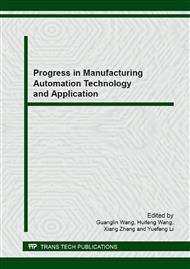p.3
p.8
p.12
p.16
p.21
p.25
p.30
p.35
Tool Diffusion Wear Mechanism in High Efficiency Machining Ti6Al4V
Abstract:
Ti6Al4V has great affinity with tool material in machining process, which easily leads to tool diffusion wear. Turning experiments were carried out to study cutting temperature and pressure at tool-chip/workpiece. Based on the analysis, a scanning electron microscopy (SEM) equipped with energy dispersive X-ray spectrometer (EDS) was used to analyze tool wear morphology. The affinity of tool and workpiece material using the Ti-W, Ti-Co diagram was also studied to elaborate the diffusion mechanism in this present study. The results shows that the cutting temperature is very high and the temperature increases with the increase of cutting speeds in machining Ti6Al4V. At the contact area, the highest temperature is located in tool rake face near to tool tip. The resilience of workpiece results in serious attrition between tool flank face and the machined surface. The highest pressure is located in tool flank face near to tool tip and the pressure in tool-workpiece interface is much higher than that in tool-chip interface. Under the high cutting temperature and high pressure at tool-chip/workpiece interface, diffusion occurred both at tool rake an flank face in machining Ti6Al4V. Because of the higher temperature at tool rake face diffusion at tool rake face ia more sever than that at tool flank face.
Info:
Periodical:
Pages:
3-7
Citation:
Online since:
September 2013
Authors:
Price:
Сopyright:
© 2014 Trans Tech Publications Ltd. All Rights Reserved
Share:
Citation:


